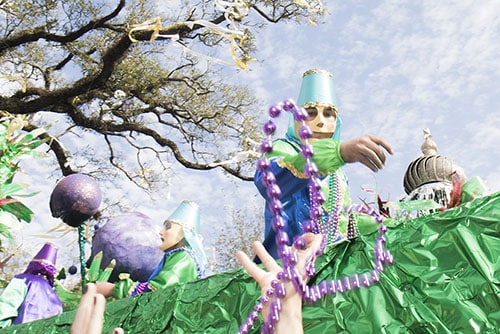
Uptown Messenger file photo
Under the regulations, all riders will have to take their beads out of the bag before throwing them. (Zach Brien, Uptown Messenger file photo)
By Sue Strachan, Uptown Messenger
Need to go to the bathroom during a parade?
For Carnival 2020, parade-goers might have to walk farther to use private port-o-lets on trucks parked in the streets.
This was part of one of two ordinances passed unanimously Thursday (Jan. 30) by the City Council “updating sections of the Municipal Code that address Mardi Gras regulations, clarifying parade terms and codifying reforms,” states a City Council press release.
Amended ordinance (Sec. 154-985 of the Code of the City of New Orleans) “Prohibits parking of a ‘box truck, cargo van, truck with a port-a-let, camper, recreational vehicle, or trailer within two blocks of a parade route between four hours before and four hours after.’”
For port-o-lets, this means that anyone who rents one and puts it in a flatbed truck or U-Haul cannot leave it overnight. In the past, people have left the truck on the street for both weekends and the days in between. Offenders can get fined or towed.
This was a big concern at a recent meeting of the Delachaise Neighborhood Association, which is bounded by Carondelet and South Saratoga streets, and Louisiana Avenue and Marengo Street, and is represented by District B Councilman Jay Banks, who sponsored the measures.
Within the boundaries is Constantinople Street off St. Charles Avenue, which has become the epicenter for parade parties, particularly those with trucks bearing port-o-lets. Couches are often off-loaded as well, creating an unwanted mini-party, residents said.
What’s not banned? Renting port-o-lets and putting them on private property, business property or a public-right-of-way, though a permit is required. Public port-o-lets set up by the city on key spots on the parade routes will return, so those living on the route hopefully won’t find their yards used as bathrooms.
Before the voted, District A Councilman Joe Giarrusso asked that an amendment be made not banning these port-o-lets, but to allow people to apply for a permit, so the city could keep track of who is in renting it. This change to the amendment was declined in a vote.
During the discussion about it, Council members Karen Gisleson Palmer and Jason Williams voiced concerns — Palmer over the extra work for the New Orleans Police Department checking permits while already stretched thin patrolling the parade route, Williams bringing up safety concerns, stating that New Orleans is one of the “softest targets in the U.S.” for terrorism due to the amount of big events here.
Collin Arnold, director of Office of Homeland Security and Emergency Preparedness said the Homeland Security’s special events director will be at the parades to assess current and future risk.
In the past, Homeland Security has treated Mardi Gras as “one day instead of 12 days of events,” said Arnold.
This is the first year that Mardi Gras has received a level 2 special event assessment rating, or SEAR, 2 level city, giving it federal resources for protection. The expectation of this is to move the city to SEAR 1 level, like the Rose Parade, and get more federal resources for protection during Mardi Gras. The rating, with SEAR 1 the greatest, uses methodology to consider the threat, vulnerability, and consequences for each event.
“Many thanks to everyone who was a part of creating this collaborative ordinance, including the Office of Homeland Security, Sanitation Department, mayor’s staff, City Council staff, as well as members of the Mayor’s Mardi Gras Advisory Committee,” Banks said. “These provisions will help ensure a safe Carnival environment for all to enjoy, free of obstructions and other security risks.”
Also on the brought before the City Council to amend and reordain Sections 34-1, 34-2, 34-14, 34-28, 34-30, 34-32, 34-33 and 34-34 of the Code of the City of New Orleans relative to Carnival and Mardi Gras.
This includes prohibited throws, parade elements such as bands and dance troupes, walking parades, and ladders and tents.
• The “prohibited throws” section was updated to prohibit parade riders from thowing: “single use plastic bags meant for throw packaging or paper streamers, or paper products that do not biodegrade when wet, or empty single-use plastic bags. Any package containing bulk throws, including but not limited to doubloons, beads, cups, trinkets, or toys shall be handed to parade attendees and shall not be thrown or tossed. Bulk throws shall be removed from any plastic packaging before being thrown or tossed.” This was proposed to help battle litter along the route, as well as alleviate the possibility of parade participants slipping on the plastic.
• “Elements” of a parade are now defined as “any marching band, military bands, dance club, walking club, riding club, or dance troupe in a Mardi Gras float parade larger than a group of fifteen participants, not including chaperones, helpers, support vehicles and public safety vehicles.”
Limits were placed on the number of elements, with a maximum of 12 before the first float, and only one element between each float.
• Mardi Gras Day walking parades are limited to the six existing parades.
• All ladders and/or personal items left on the public right-of-way must be removed four hours or more before a parade, and at the end of the final parade that same day. Ladders cannot be chained together. The use of ropes, spray paint or other similar items to create a barricade or otherwise obstruct passages along public property, unless otherwise specifically authorized, is prohibited. Enclosed tents are now prohibited on sidewalks and neutral grounds.